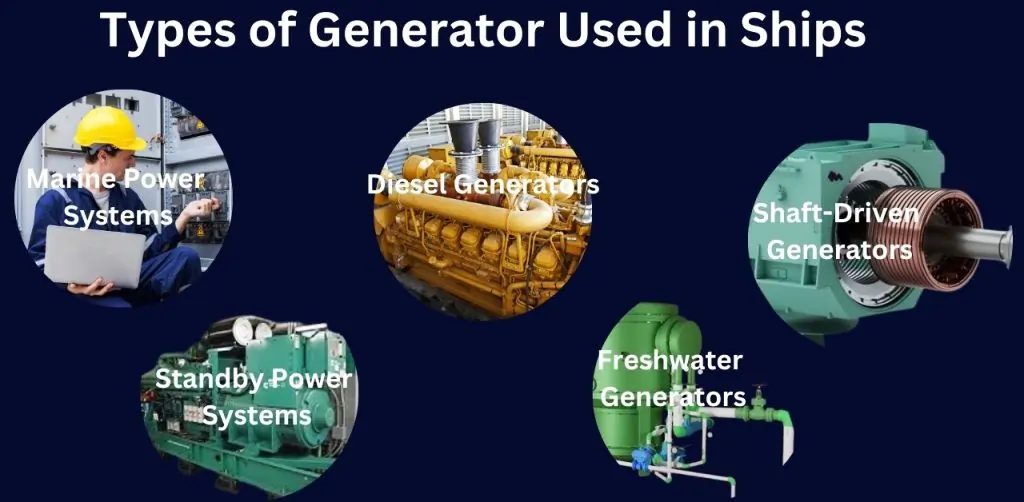On ships, having a reliable power source is essential, and understanding the types of generators used in ships is key. These generators power the ship’s systems and equipment, keeping everything running smoothly. From the common diesel generators to shaft-driven generators and standby generators, each type has an important role. In this blog post, we’ll explore the different types of generators, their key functions, and why choosing the right one is essential for efficiency, safety, and long-term performance in the maritime industry.
Types of Generator Used in Ships
Marine Power Systems: The Backbone of Ship Operations
Design:
Marine power systems, particularly marine generators, are engineered with durability and efficiency in mind. These generators are designed to withstand the harsh marine environment, with features like compact sizes for space-saving and resistance to corrosion and moisture. These design elements are crucial to ensure that the generators continue to function reliably even in challenging conditions at sea, where exposure to saltwater and humidity is a constant factor.
Purpose:
The primary purpose of marine generators is to provide consistent and reliable power to a ship’s essential systems and equipment. These generators ensure that everything from navigation tools and communication systems to lighting and air conditioning continues to operate smoothly throughout the voyage. Built specifically for marine environments, marine generators are critical in supporting the overall functionality and safety of the vessel, helping to maintain operations seamlessly without interruptions.
Diesel Generators: Reliable Energy for Daily Operations
Fuel:
Diesel generators rely on diesel, a type of hydrocarbon fuel known for its efficiency and cost-effectiveness. Diesel is widely used in the maritime industry due to its high energy density, which allows ships to operate for extended periods without the need for frequent refueling. Its availability, stability, and affordability make it an ideal choice for powering vessels on long voyages, especially in remote locations where refueling options are limited.
Purpose:
Diesel generators are a primary and dependable source of energy for ships. They provide consistent power to a vessel’s essential systems, including navigation equipment, lighting, communication tools, and air conditioning. Diesel generators are favored for their reliability, as they can operate for long hours under demanding conditions. Their durability and ease of maintenance make them a vital component of a ship’s power system, ensuring smooth and uninterrupted operations throughout the journey.
Shaft-Driven Generators: Power from the Propeller
Location:
Shaft-driven generators are strategically placed within the shaft line, positioned between the propeller and the main diesel engine. This placement allows them to harness mechanical energy directly from the propulsion system. As the propeller rotates, it transfers power through the shaft, providing a continuous energy source to operate the generator.
Operation:
Shaft generators operate through a system known as power take-off (PTO). The PTO mechanism draws energy from the rotating shaft and transmits it to the generator. A reduction gear is used to adjust the rotational speed, ensuring that the generator runs at the optimal speed for efficient power generation. This system allows the shaft generator to generate electricity without relying on separate fuel sources, making it an energy-efficient option for providing electrical power to a ship’s systems.
Standby Power Systems: Ensuring Safety and Continuity for the Marine Industry and Ships
Purpose:
Standby power systems are crucial for ensuring that ships maintain continuous operations, even during power failures or emergencies. These systems are designed to provide backup electricity when the main power source fails, ensuring that essential systems such as navigation, communication, lighting, and safety equipment remain functional. This reliability is vital to the safety and security of the crew, vessel, and cargo, especially in critical situations when uninterrupted power is required.
Importance in the Marine Industry:
In the maritime industry, standby power systems are indispensable for maintaining the safety and operational integrity of ships. They are typically activated automatically when a power loss occurs, preventing disruption to ship functions. Standby generators are particularly important in sectors such as commercial shipping, cruise lines, and offshore operations, where any downtime can have significant consequences. By ensuring that the vessel remains operational, these systems help avoid costly delays and safety risks, supporting the smooth and safe navigation of the ship across its journey.
Freshwater Production: Generators That Convert Seawater to Freshwater
Purpose:
Freshwater generators are essential for converting seawater, well water, or even polluted industrial water into freshwater, a vital resource for ships at sea. Since ships operate in environments where freshwater sources are scarce, these generators ensure a continuous supply of drinking water, water for sanitation, and water for other critical onboard operations. The process typically involves distillation or reverse osmosis, where seawater is purified and treated to remove salts and contaminants, making it safe for consumption and use.
Importance for Ships:
Freshwater is a key necessity for crew members and ship operations. Freshwater generators allow ships to be self-sufficient while at sea, eliminating the need for frequent refueling or restocking of water supplies. These systems are especially crucial for long voyages, where access to ports or freshwater sources may be limited. By converting seawater into freshwater, these generators contribute to both the health and operational efficiency of the vessel, ensuring that the ship can function smoothly without any interruptions related to water shortages.
FAQ: Types of Generator Used in Ships
Q: What is the most common type of generator used on ships?
A: Diesel generators are the most common due to their reliability and efficiency.
Q: How do shaft-driven generators work on ships?
A2: They generate power using energy from the rotating propeller
Q: What is the purpose of standby generators on ships?
A: They provide backup power during main power failure.
Q: Why are freshwater generators important on ships?
A: They convert seawater into fresh drinking water for the crew.
Conclusion
In this blog post, we’ve explored the different types of generators used on ships, each playing a vital role in ensuring smooth and efficient operations. From diesel generators providing reliable power for daily functions to shaft-driven generators utilizing energy from the propeller, and standby power systems ensuring safety during emergencies, each system has its unique contribution. Additionally, freshwater generators help convert seawater into drinkable water, ensuring the well-being of the crew and operational continuity.
Selecting the right generator type is crucial for maintaining ship efficiency, safety, and reliability. The proper generator system ensures that ships can run seamlessly, even in harsh conditions, contributing to overall operational success.
Looking ahead to 2025 and beyond, we can expect continued advancements in marine power generation technologies. With an increasing focus on sustainability, automation, and efficiency, the future of marine generators is set to become even more efficient, helping ships reduce emissions, save energy, and operate in an eco-friendly manner, ensuring a greener future for the maritime industry.

